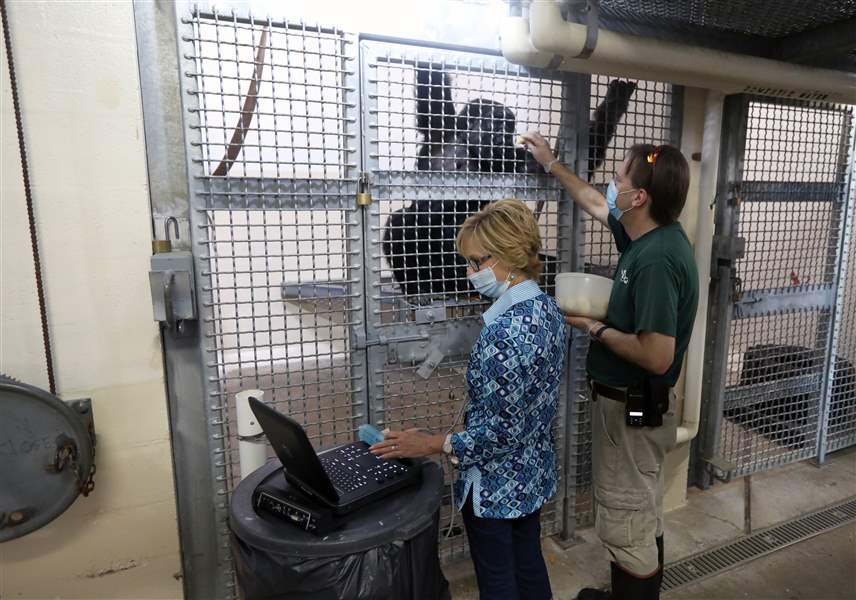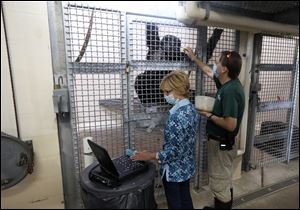
Baby on the way for Toledo Zoo gorilla Sufi
5/25/2018
Connie Warner, an ultrasound technologist and Toledo Zoo volunteer, left, takes an ultrasound of 16-year-old Sufi Bettine, a pregnant female western lowland gorilla who arrived in Toledo on a breeding loan last May. Keeper Mike Payne, right, feeds fruit treats to her during the procedure. Sufi is expected to give birth to her first baby in the late summer or early fall.
The Blade/Amy E. Voigt
Buy This Image
Her hairy belly pressed against sturdy steel mesh, Sufi Bettine ate piece after piece of fruit while she waited for her exam to finish Thursday morning.
The 16-year-old western lowland gorilla took no interest in the fuzzy, black-and-white image on a nearby screen. But the ultrasound technician watched closely as a small head, spine, and other features appeared.
Sufi is pregnant, on track to deliver her first baby sometime in the late summer or early fall.
WATCH: Toledo Zoo officials and volunteers perform an ultrasound on Sufi
“So far, we couldn’t be happier with the way things are going for her,” Michael Frushour, curator of mammals at the Toledo Zoo, said. “She’s a first-time mom and we’re cautiously optimistic. You never really know what’s going to happen. Even with experienced mothers, there can be complications just like with humans.”
Sufi came to the Glass City a year ago on a breeding loan from the Houston Zoo. The Species Survival Plan for western lowland gorillas, a program of the Association of Zoos and Aquariums that oversees breeding in accredited facilities, recommended her as a new mate for Toledo’s silverback male, Kwisha.
“They took to each other immediately,” Mr. Frushour said.
Sufi’s baby will be the second born at the zoo recently. Mokonzi, a male born to Kitani at Thanksgiving, turned 6 months old Thursday. His was the first gorilla birth at the zoo since 2003.
WATCH: Toledo Zoo welcomes baby gorilla
Mr. Frushour said Sufi has been very curious about Mokonzi, and seeing an experienced female give birth and care for an infant can only help when it comes time to welcome her own.

Connie Warner, an ultrasound technologist and Toledo Zoo volunteer, left, takes an ultrasound of 16-year-old Sufi Bettine, a pregnant female western lowland gorilla who arrived in Toledo on a breeding loan last May. Keeper Mike Payne, right, feeds fruit treats to her during the procedure. Sufi is expected to give birth to her first baby in the late summer or early fall.
Connie Warner, a medical ultrasonographer and longtime zoo volunteer, has been performing ultrasounds on zoo animals for 19 years. The procedure is not as different from a human ultrasound as one might think.
“I look for everything I would as if I were working on a human,” Ms. Warner said, listing off the placenta, amniotic fluid, heart, and taking measurements of the head, abdomen, and long bones. “It’s essentially identical. All I do is adjust the gestational period for each of the animals.”
Primates in particular are so similar to humans it’s easy to forget you’re working with an animal. Ms. Warner still remembers her confusion years ago during an orangutan ultrasound when she couldn’t make sense of why the measurement of the fetus’ humerus bone seemed so off.
“Then it hit me — they have really long arms,” she said, laughing.
The animals’ hair is the only factor that really presents a challenge, Ms. Warner said, because it absorbs the sound waves the machine uses. The images tend to be blurry and it’s more difficult to see detail.
It’s one reason no one will know for sure whether Sufi’s baby is male or female until birth. Though Ms. Warner said she and zoo staff were fairly sure Mokonzi was a boy before he was born, hazy ultrasound images make determining the sex difficult.
“We’re still up in the air with this one,” she said.
Keepers train zoo animals to position themselves and accept various medical procedures without needing sedation. Ms. Warner comes in monthly to train with primates so they are accustomed both to the procedure and to her.
“If and when they become pregnant, then we increase the amount of time I’m present to every two weeks or every one week toward the end of a pregnancy,” she said.
Staff veterinarian Dr. Kirsten Thomas said frequent ultrasounds ensure pregnancies are going well, particularly for first-time mothers like Sufi. It also helps keepers to know when to expect a birth so they can make appropriate preparations and keep a very close eye on their charges.
“When birth is imminent, we’ll be checking much more frequently,” Dr. Thomas said.
The gestation period for gorillas is about 8 1/2 months. Sufi has shown only a few noticeable signs thus far, which are very similar to symptoms a human woman might experience.
“She does have little bit of morning sickness and we’ve been treating that,” Dr. Thomas said. “She’s getting Pepcid and ginger, which is what you would do for a human, and she’s been feeling a lot better.”
Gorilla bellies are naturally round and Sufi has not had a baby before, so she isn’t showing yet. But she should eventually get bigger and rounder and look pregnant. Sufi has also reportedly been lactating while on exhibit, which Dr. Thomas said is normal and typically a good sign she’ll be able to nurse her infant.
The zoo is prepared to manage any number of potential complications that may arise as things progress, including delivering the baby by Cesarean section if necessary. Sufi’s pregnancy has fortunately been smooth sailing thus far.
“She’s been doing really well overall,” the veterinarian said. “She’s making my life very easy.”
Western lowland gorillas, found in the heavy rain forests of west central Africa, are listed on the International Union for the Conservation of Nature and Natural Resources' Red List as critically endangered.
Contact Alexandra Mester at: amester@theblade.com, 419-724-6066, or on Twitter @AlexMesterBlade.